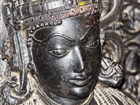Karnataka,
like Tamil Nadu, is very much about temples, priests, and
pujas. After
all, it’s not every day that you walk around a corner and Lord
Shiva is
there, doing his dance. That it’s a sculpture of him on the
wall of a
temple is of less importance if it’s done by a master
craftsman and,
for just a moment, it appears to leap out of the niche it’s
been
consigned to all these years.
Then you blink and, of course, the sculpture is back in the niche. Where Lord Shiva is God only knows.
Naturally, Karnataka is more than just its temples. There’s a lot of natural beauty at the ocean, at sea level inland, and in its hill stations. There are great palaces in the state, most notably in Mysore, where the design melds a number of European and Indian architectural styles to create something radically new. Mysore sandalwood is well known (and now, because the trees have been over-harvested, as expensive as gold) for incense, soaps, oils, and beads. And we all speak to someone in Bangalore -- every time we make a credit card complaint call.
The temples have prominence, however, for the traveler who visits the grand cities of earlier empires which flourished in what is now central Karnataka. The Chalukyas (5th to 9th C) built the first stone temples. These are notable for using north Indian and south Indian design elements to create a new style of great artistry, elegance, and strength. The current sites at Badami, Aihole (pronounced Eye-hoe-lay), Pattadakal, and Mahakuta have a number of representative structures from that early period.
The sculptors and architects of the Hoysala empire (12C to 14C) ornamented their stone temples with scenes from the Ramayana and the Mahabarata as well as displays with the trappings of royalty. The most breathtaking statues on these temples, though, are those of the gods, often with their “vehicle” (vahana) -- the animal form that they ride or who accompanies them. We see Shiva with Nandi the bull, Ganesh and the rat, Durga with her lion, Murugan on his peacock, and Indra with his elephant. Incarnations of Vishnu make frequent appearances, especially Varaha -- part boar, part man -- and Narasingha -- part lion, part man. The glorious Hoysala temples are at Halebid, Belur, and Somnathpur.
The most renowned ancient site in Karnataka is the city of Hampi which flourished from the 14th to the 16th centuries. The city was vast and the ruins are likewise vast, although with only a small and select portion of the original site unearthed and available for a visit. The two most impressive single sites in Hampi are temple complexes.
Then you blink and, of course, the sculpture is back in the niche. Where Lord Shiva is God only knows.
Naturally, Karnataka is more than just its temples. There’s a lot of natural beauty at the ocean, at sea level inland, and in its hill stations. There are great palaces in the state, most notably in Mysore, where the design melds a number of European and Indian architectural styles to create something radically new. Mysore sandalwood is well known (and now, because the trees have been over-harvested, as expensive as gold) for incense, soaps, oils, and beads. And we all speak to someone in Bangalore -- every time we make a credit card complaint call.
The temples have prominence, however, for the traveler who visits the grand cities of earlier empires which flourished in what is now central Karnataka. The Chalukyas (5th to 9th C) built the first stone temples. These are notable for using north Indian and south Indian design elements to create a new style of great artistry, elegance, and strength. The current sites at Badami, Aihole (pronounced Eye-hoe-lay), Pattadakal, and Mahakuta have a number of representative structures from that early period.
The sculptors and architects of the Hoysala empire (12C to 14C) ornamented their stone temples with scenes from the Ramayana and the Mahabarata as well as displays with the trappings of royalty. The most breathtaking statues on these temples, though, are those of the gods, often with their “vehicle” (vahana) -- the animal form that they ride or who accompanies them. We see Shiva with Nandi the bull, Ganesh and the rat, Durga with her lion, Murugan on his peacock, and Indra with his elephant. Incarnations of Vishnu make frequent appearances, especially Varaha -- part boar, part man -- and Narasingha -- part lion, part man. The glorious Hoysala temples are at Halebid, Belur, and Somnathpur.
The most renowned ancient site in Karnataka is the city of Hampi which flourished from the 14th to the 16th centuries. The city was vast and the ruins are likewise vast, although with only a small and select portion of the original site unearthed and available for a visit. The two most impressive single sites in Hampi are temple complexes.

